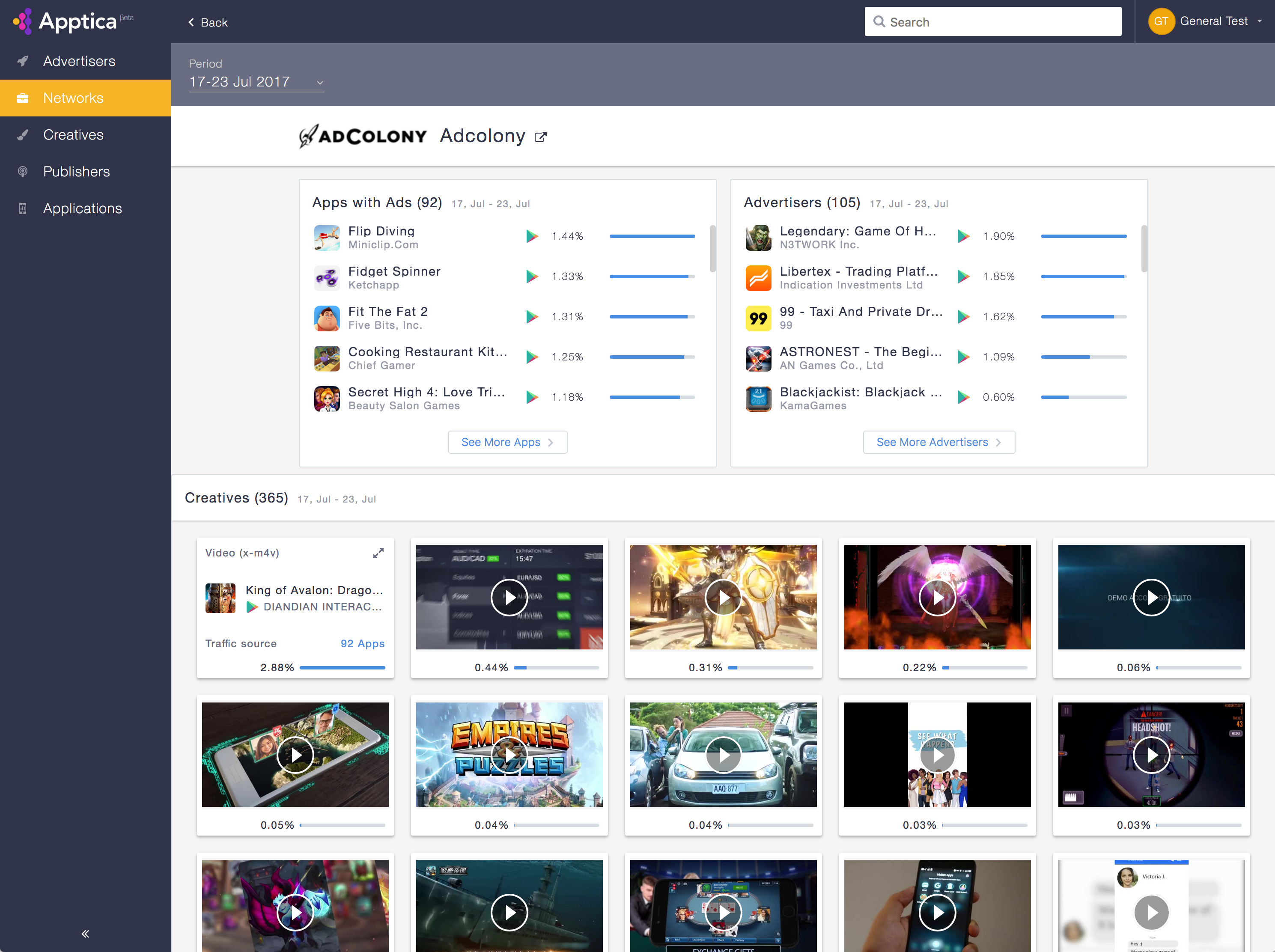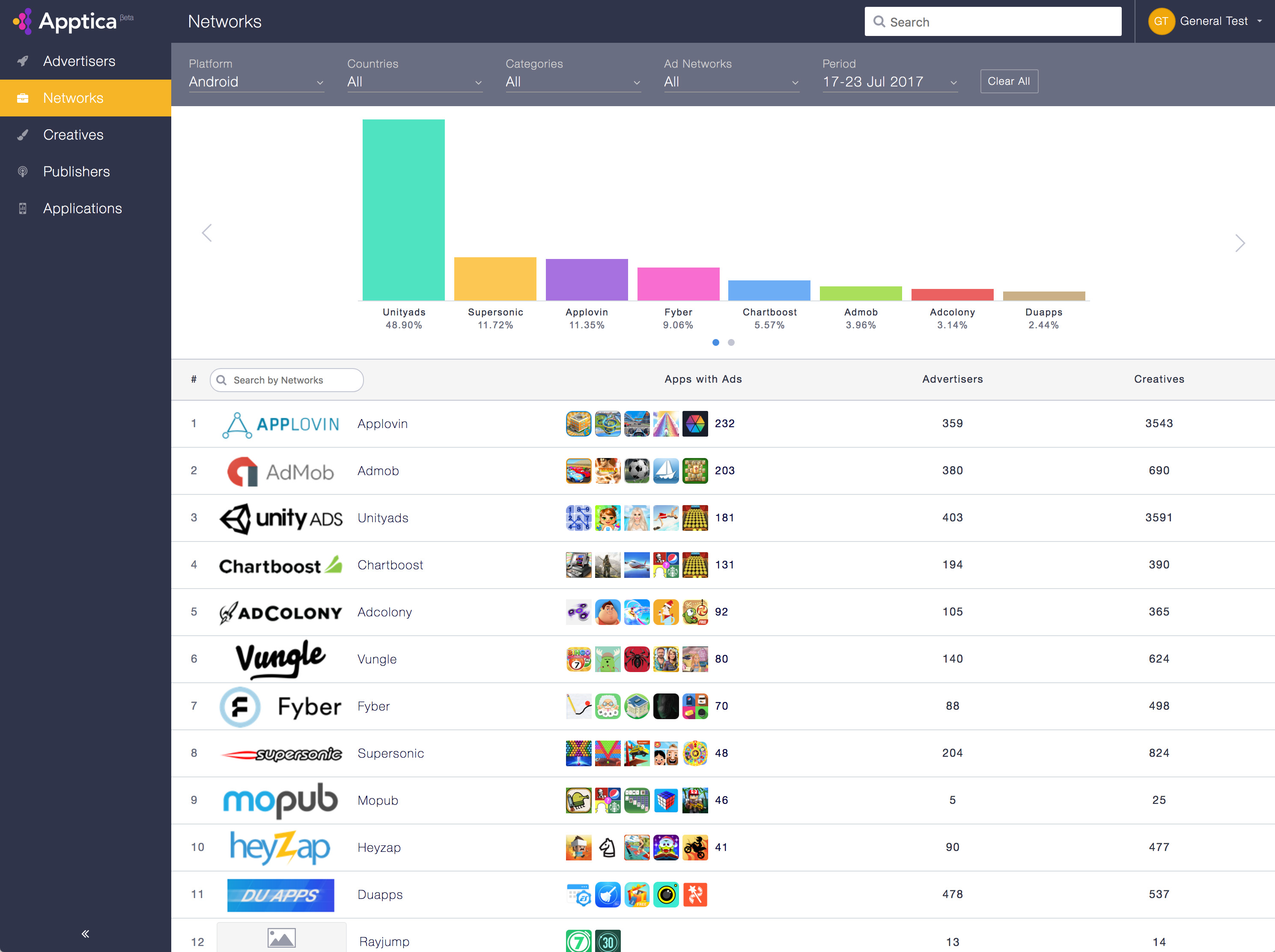In early July, the Apptica mobile advertising monitoring service was launched as part of the public beta. It tracks and shows which creatives and advertising grids are used by mobile publishers. About why game developers need such a service, App2Top.ru I asked the CEO of Apptica Anton Buchelnikov.
Alexander Semenov, Senior Editor App2Top.ru Questioner: Let‘s start with the background of the project. How did it all start?

Anton Buchelnikov
Anton Buchelnikov, CEO of Apptica: We used to try to make apps ourselves and at one point were puzzled by how to properly purchase traffic on them.
There was nowhere to look at the strategies of those we would like to focus on. There were questions: which network to go to, which creatives to use, and in general what kind of advertising format would be effective on our subject?
A similar story concerned the issue of monetization – which SDK to install, in what form to display ads in your application?
It was more than a year ago. Then we did not find any service about advertising inside applications at all. It seemed that we identified a group of problems related to understanding how the advertising market in applications works. They began to find out from large advertisers whether they have a need for monitoring of this kind. Realizing that they are able to make a useful product, they set to work.
What should Apptica, in theory, be able to do after exiting beta?
Anton: It will show in detail how the market works. The service will answer questions such as:
- which networks are in which applications (in the context of Android and iOS platforms, different categories of applications and dozens of countries);
- which advertisers are present on the market and what is their activity;
- from which sources do they buy traffic and to what extent;
- what advertising formats are being purchased for and what the creatives themselves look like.
In addition to studying competitors, it will be possible to carry out a kind of brand-saving.
For an advertiser, this is a check on which creatives and from where partners bring traffic to your product, to identify mislid or materials that violate the idea of advertising your own brand.
For publishers, this is a test of advertising on their own site, checking what exactly users from different countries see in your application.
In fact, this is all the monitoring functionality, what we start with. We will start from this in the future by developing the service, making it possible to compare selected data and doing market analytics.
What can the service do now?
Anton: Already a lot of what will be in the first paid version. Only so far we have one platform – Android, and not so much data. In the future, there will be more networks, countries and, most importantly, advertising offers and traffic sources.
Now we provide the ability to search in the system by platform, advertiser, publisher, creatives, advertising networks, countries, categories and period.
For the release, we decided not to wait for the appearance of all the functionality. We are developing it, periodically releasing innovations in the release. We receive feedback on them from testers and future customers.
Where does the data come from?
Anton: From applications, advertising is also shown in them. We collect data about what is advertised where, what users from different countries see in the applications they use.
The collection method is very complex, which makes it difficult to develop our project. We have to aggregate data from different sources, process them, resulting in one view and get statistics that can already be shown to users in the interface.
In your promotional materials, you call yourself the first such service. What about Appscotch, which is now part of App Annie?
Anton: App Annie is a huge product. His new service concerning advertising has not yet gained popularity. Largely due to the high cost and limited presentation to market participants.
We are making a tool specifically about advertising inside applications, this is really the first analytics of this kind aimed at solving the problems of advertisers and publishers.
Is there any scenario for working with the service? For example, I have a three-in-a-row, I’m preparing an advertising campaign in Russia, why do I need your service?
Anton: Look, you need to buy traffic, and at the same time do it optimally in a new region. You can walk the path yourself, having tried your luck in terms of choosing partners, traffic sources, formats and long-term testing of invented creatives. And you can see how it is done by those you focus on when making your product – on successful game developers in this case.
Our service does not sell or buy advertising itself. We give the client the opportunity to understand the strategy of competitors. The developer can find out the white lists of sources, evaluate the activity by days of the week, see in which networks other companies tried to purchase, in which they stopped, and where they increased, which advertising format they used, which creatives did not receive a budget, and which, on the contrary, turned out to be the most effective.
With regard to creatives directly. Of course, no one will take someone else’s banner, it’s strange. This may be of interest only to arbitrageurs who attract traffic to the offer taken in the aggregator. But on the other hand, the media buyer of your product can evaluate other people’s creatives, borrow their ideas, see what doesn’t work and eventually make it no worse.
In general, it seems to me that such a product gives a positive impetus to the development of the industry. Strategies of successful players, becoming available, help to create more successful advertising, come up with new successful content solutions, attract traffic from reliable sources through honest partners.
Are there already cases in which you have helped to increase the profit from advertising when using the service?
Anton: We are still in beta and I think we will hear real words of gratitude in the future.
Have you already gained expertise in terms of understanding what it means, for example, if such and such an advertiser uses the corresponding video at this moment, and at another – completely different?
Anton: We ourselves have not yet begun to monitor the market so closely to draw confident conclusions. This is the next stage. This is exactly our goal – to do monitoring, to do analytics. But I can say that interesting trends can be noticed right now.
Appscotch had a cool function: it gave an estimated CPI for each campaign, which made it possible to roughly represent the cost of advertising competitive products. Are you planning such a solution?
Anton: We are planning. We don’t do it right away because we don’t want to “invent” the data. The cost of traffic is a complex parameter that depends on many factors. In analytics, in any case, there is an approximation of data, but its accuracy directly depends on the technology. We have some interesting ideas on what to do about it.
Does he plan to add a status by position in the top of applications, because this will allow him to correlate the success of competitors’ advertising campaigns with their position in the top?
Anton: Yes, a little later. This is simpler than what we are analyzing, but there is not enough strength for everything at once.
We will also definitely get to a very useful function – providing contacts of publishers, networks and advertisers.
While I was studying creatives, I realized that there was not enough opportunity to find out their conversion into transitions to the application page or at least into clicks. Is it really possible to implement such things?
Anton: This is a difficult task and we are solving it in a different way. Every major advertiser has tools to evaluate the effectiveness of campaigns and individual creatives. We analyze how the advertiser spends the budget on certain creatives and, based on this, we build their rating. As a result, we can fairly reliably determine what users click on and which creatives have the highest conversion.
You don’t have Facebook yet, the main traffic channel. What is the reason for this and is it worth waiting for its appearance?
Anton: Facebook and its mobile app as a traffic source is a separate specific story. We don’t plan to show it in Apptica in the near future.
So far, I do not know who would be able to present the native advertising that users are shown in the social network news feed really well. However, there is also a Facebook Audience framework, the SDK of which is embedded in other applications. Its advertising is worth waiting for in our service.
You don’t measure the number of campaigns launched for each game, only the number of ads per application, why?
Anton: We just didn’t have time. There are a lot of grandiose ideas and wishes from customers ahead.
We are working on the division into campaigns. We will also do an analysis of advertising formats. Over time, we will present product offers (advertising of non-applications), get to pre-landings, aggregate where open offers are taken, show click-urls and give the opportunity to target sites with low-quality traffic and creatives that violate the advertiser’s brand or sites.
What will the money be taken for?
Anton: For access to the service by subscription.
We plan to create three tariffs: Basic, Advanced and Combined, depending on the needs of customers.
The basic one will include information on the top advertising networks in the in-app, advertisers for purchasing and publishers for selling in-app traffic. Detailed information on creatives will be available for all categories in one selected country, for one user.
How much are you planning to take?
Anton: From $299 for the basic tariff and from $890 for the extended tariff. Further depending on the specific needs of the user. We will provide discount options.
How soon do you plan to exit beta?
Anton: I think it will be in early autumn. We are actively working on it!
At the moment, we provide access to the service for free, as we are in the process of collecting complete data. We are actively working on improving the service and will be glad to receive comments and feedback!




